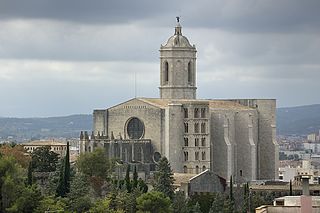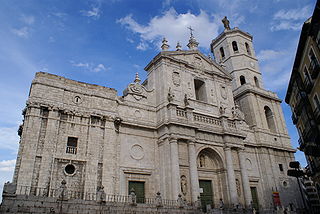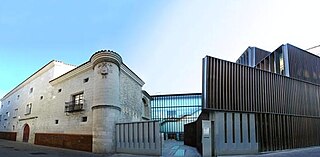
Renaissance architecture is the European architecture of the period between the early 14th and early 16th centuries in different regions, demonstrating a conscious revival and development of certain elements of ancient Greek and Roman thought and material culture. Stylistically, Renaissance architecture followed Gothic architecture and was succeeded by Baroque architecture. Developed first in Florence, with Filippo Brunelleschi as one of its innovators, the Renaissance style quickly spread to other Italian cities. The style was carried to France, Germany, England, Russia and other parts of Europe at different dates and with varying degrees of impact.

The Cathedral of Saint Mary of Burgos is a Catholic church dedicated to the Virgin Mary located in the historical center of the Spanish city of Burgos. Its official name is Santa Iglesia Catedral Basílica Metropolitana de Santa María de Burgos.

The Palau de la Generalitat de Catalunya is a historic palace in Barcelona, Catalonia, Spain. It houses the offices of the Presidency of the Generalitat de Catalunya. It is one of the few buildings of medieval origin in Europe that still functions as a seat of government and houses the institution that originally built it.

Plateresque, meaning "in the manner of a silversmith", was an artistic movement, especially architectural, developed in Spain and its territories, which appeared between the late Gothic and early Renaissance in the late 15th century, and spread over the next two centuries. It is a modification of Gothic spatial concepts and an eclectic blend of Mudéjar, Flamboyant Gothic and Lombard decorative components, as well as Renaissance elements of Tuscan origin.

Renaissance Revival architecture is a group of 19th century architectural revival styles which were neither Greek Revival nor Gothic Revival but which instead drew inspiration from a wide range of classicizing Italian modes. Under the broad designation "Renaissance architecture" nineteenth-century architects and critics went beyond the architectural style which began in Florence and central Italy in the early 15th century as an expression of Renaissance humanism; they also included styles we would identify as Mannerist or Baroque. Self-applied style designations were rife in the mid- and later nineteenth century: "Neo-Renaissance" might be applied by contemporaries to structures that others called "Italianate", or when many French Baroque features are present.

Girona Cathedral, also known as the Cathedral of Saint Mary of Girona, is a Roman Catholic church located in Girona, Catalonia, Spain. It is the seat of the Roman Catholic Diocese of Girona. The cathedral's interior includes the widest Gothic nave in the world, with a width of 22 metres (72 ft), and the second-widest of any church after that of St. Peter's Basilica. Its construction was begun in the 11th century in the Romanesque architectural style, and continued in the 13th century in the Gothic style. Of the original Romanesque edifice only the 12th-century cloister and a bell tower remain. The second bell tower was completed in the 18th century.

Atessa is an municipality in the province of Chieti, Abruzzo, south-eastern Italy. It is part of the Val di Sangro mountain community. It is the largest municipality in the province by extension and eighth by population.

The Monastery of Jesus is a historical religious building in Setúbal, Portugal, which served a monastery of Poor Clare nuns. It is one of the first buildings in the Manueline style, the Portuguese version of late Gothic. The cloisters of the complex houses a museum of the monastery.

Venetian Gothic is the local variant architectural style for Venice of Italian Gothic architecture, with a confluence of influences from local building requirements, some influence from Byzantine architecture, and some from Islamic architecture, reflecting Venice's trading network. Very unusually for medieval architecture, the style is both at its most characteristic in secular buildings, and the great majority of survivals are secular.

The Mosque of Cristo de la Luz is a former mosque in Toledo, Spain. It is the one of the ten that existed in the city during the Moorish period. The edifice was then known as Mezquita Bab-al-Mardum, deriving its name from the city gate Bab al-Mardum. It is located near the Puerta del Sol, in an area of the city once called Medina where wealthy Muslims used to live.

Prato Cathedral is a Roman Catholic cathedral in Prato, Tuscany, Central Italy, from 1954 the seat of the Bishop of Prato, having been previously, from 1653, a cathedral in the Diocese of Pistoia and Prato. It is dedicated to Saint Stephen, the first Christian martyr.

French architecture ranks high among France's many accomplishments. Indications of the special importance of architecture in France were the founding of the Academy of Architecture in 1671, the first such institution anywhere in Europe, and the establishment in 1720 of the Prix de Rome in architecture, a competition of national interest, funded by the state, and an honor intensely pursued. If the first period of France's preeminent achievement was the Gothic, and the second, the eighteenth century, the longer tradition of French architecture has always been an esteemed one.

Pamplona Cathedral(Santa María la Real) is a Roman Catholic church in the archdiocese of Pamplona, Spain. The current 15th century Gothic church replaced an older Romanesque one. Archaeological excavations have revealed the existence of other two previous churches. The Neoclassical façade was designed by Ventura Rodríguez in 1783. It has a 13th-14th-century Gothic cloister, that gives access to two other Gothic rooms: the Barbazan chapel and the refectory. The Mediaeval kings of Navarre were crowned there and some of them were also buried. The Navarrese Cortes (Parliament) was held there even during the early modern ages.

Alcoy or Alcoi is an industrial and university city, region and municipality located in the province of Alicante, Spain. The Serpis river crosses the municipal boundary of Alcoi. The local authority reported a population of 61,135 residents in 2018.

The Monastery of Sant Jeroni de Cotalba is a monastic building of Valencian Gothic, Mudéjar, Renaissance, Baroque and Neoclassical styles constructed between the 14th and 18th centuries, located in the municipal area of Alfauir, (Valencia), Spain, about 8 km. from the well-known city of Gandia.

The Cathedral of Our Lady of the Holy Assumption, better known as Valladolid Cathedral, is a Roman Catholic church in Valladolid, Spain. The main layout was designed by Juan de Herrera in a Renaissance-style.

The Cathedral of St Justus and St Pastor in Alcalá de Henares is a Roman Catholic cathedral located in Alcalá de Henares, Spain. It was declared Bien de Interés Cultural in 1904.

The Fournier Museum of Playing Cards is a playing card museum located in Vitoria, Spain. It originated as a private collection in 1916 by Félix Alfaro Fournier, the grandson of the founder of Naipes Heraclio Fournier. It was bought by the government of Álava and was declared Bien de Interés Cultural in 1984. In 1994, it moved to its current location in the Bendaña palace which it shares with the Álava Museum of Archaeology.

The Old Town Hall in Prague, the capital of the Czech Republic, is one of the city's most visited monuments. It is located in Old Town Square.

Valencian Gothic is an architectural style. It occurred under the Kingdom of Valencia between the 13th and 15th centuries, which places it at the end of the European Gothic period and at the beginning of the Renaissance. The term "Valencian Gothic" is confined to the Kingdom of Valencia and its area of influence, which has its own characteristics.




















